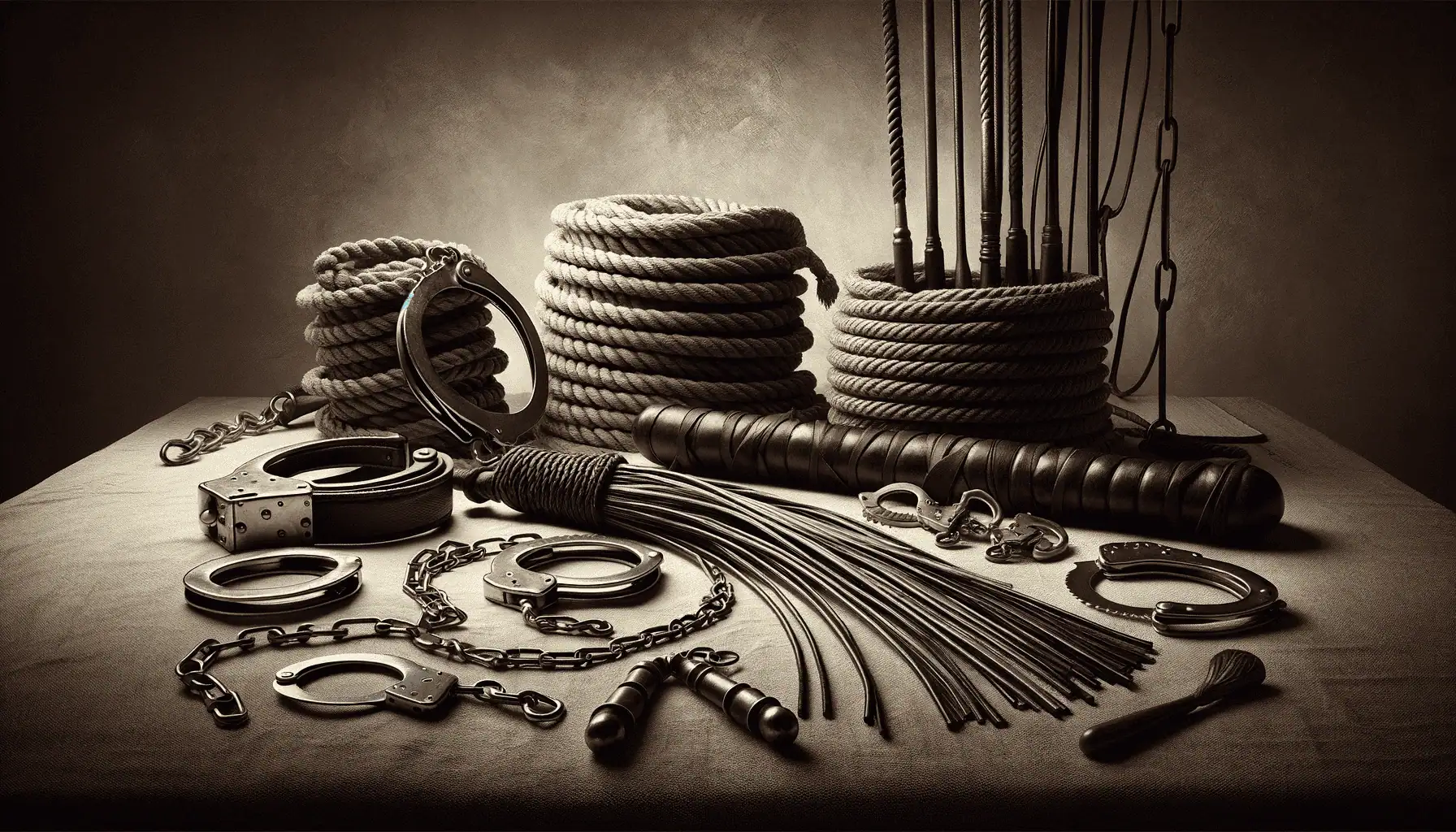
Bondage Techniques and Tools: Your Ultimate Guide to Safe and Exciting Play
Ready to dive into bondage but not sure where to start? This no-nonsense guide equips you with vital know-how information on the safest and most exciting instruments and practices. From choosing durable restraints to tying secure knots to learning everything needed to elevate your bondage play safely. Whether you’re a curious novice or looking to refine your expertise, brace yourself for a journey into the thrilling dynamics of restraint without any fluff.
Key Takeaways
- Quality BDSM contraptions like leather handcuffs, ankle cuffs, nylon ropes, and sensory devices are essentials for a safe and stimulating bondage experience.
- Learning proper knot techniques and starting with simple positions is key for beginners, while safety measures like using safe words and having emergency scissors on hand ensure a secure play for all participants.
- Aftercare is essential in the practice of bondage to provide physical and emotional support, helping participants return to normalcy while maintaining mutual respect and care.
Essential Bondage Implements: The Key to Unlocking Pleasure

Bondage tools are the key to unlocking the thrilling world of BDSM fetish play. Adult sex toys, from leather cuffs to bondage rope and even a bondage belt, create a multitude of possibilities for pleasure and control, enabling you to experiment with various positions and scenarios. But remember, when it comes to bondage, quality matters. Tools made of quality materials like nylon rope and faux leather offer durability, versatility, and comfort, ensuring a safe and enjoyable bondage experience with bondage restraints.
We’ll go further into bondage restraints, sensory tools, and advanced equipment. Each category offers a unique blend of pleasure and control that can add an exciting twist to your bondage experience.
Choosing Your Restraints
The selection of appropriate restraints is a key part of developing a pleasurable bondage experience. For beginners, balance is key. Some options for comfortable yet effective restraints include:
- Soft fabric or fur-lined collars
- High-quality leather collars
- Fluffy handcuffs
- Nylon ropes
Not quite ready for ropes? No worries! Handcuffs, ankle cuffs, and hogties are easy-to-use restraints that can introduce you to the exhilarating world of bondage. If your wife wants to be tied up but you’re both new to the scene, these simple tools offer a safe, exciting place to start while building trust and comfort.
And what about those tantalizing leather cuffs? Leather cuffs are visually appealing and offer exceptional quality and durability. Adjustable straps ensure a secure and comfortable fit while enhancing the overall bondage experience.
The Enchantment of Sensory Devices
Sensory tools enhance the bondage experience by intensifying the senses and boosting pleasure. Take blindfolds, for instance. They are a type of sensory deprivation tool that can make the person restrained and sensitive to touch, turning every stroke into a wave of ecstasy.
And what about bondage tape? It’s not just for restraints. Bondage tape can intensify focus on bodily sensations when wrapped over the eyes or mouth, creating a tantalizing play of anticipation and pleasure. For a comfortable fit and easy removal, satin and leather are often the materials of choice for blindfolds.
Advanced Equipment
For enthusiasts seeking a heightened experience, advanced bondage equipment, such as BDSM stands, can elevate the excitement. Anal hooks, used in predicament bondage, can maintain a submissive in a vulnerable position, adding a delicious touch of humiliation to the scenario.
Then there’s the humbler, a preferred tool for practitioners interested in furthering humiliation and degradation play. And let’s not forget about suspension bars, which can add a breathtaking element of aerial play to your bondage session.
For a unique blend of sensations and aesthetics, bamboo bondage techniques offer a fresh and exciting challenge for intermediate practitioners, including breast bondage variations.
Crafting Your Bondage Experience

Creating an unforgettable bondage experience entails:
- Mastery of basic ties
- Willingness to explore different positions
- Understanding of predicament bondage dynamics
- Clear communication using safe words and regular check-ins to ensure safety and enjoyment for all involved.
Starting with easily achievable and maintainable positions and restraints is crucial, especially for beginners. During play, frequent check-ins with your restrained partner, adjusting ropes, and staying attentive to the restrained’s responses and breathing are vital for preventing discomfort or injury.
Mastering Basic Ties
Achieving the perfect knot is an art form, with mastery of basic ties being the initial step towards a safe and comfortable bondage experience. When tying wrists and ankles, it’s crucial to ensure the ropes are secure without being overly tight, as this can prevent nerve damage. And remember the one-finger rule? Always ensure you can slide one finger under the rope to prevent it from being too tight and causing rope burn.
Before engaging in bondage, partners should recognize and agree upon any off-limit areas on the body to maintain the safety and comfort of all participants.
Exploring Bondage Positions
Investigating different positions can inject novelty into your bondage adventure. For beginners, it’s best to start with simple positions that don’t require much flexibility or endurance, ensuring a safe and comfortable experience.
Introducing new bondage activities slowly and gradually can prevent overwhelming the participants. This approach also allows you to gauge individual responses to different positions, balancing control and vulnerability and paving the way for a satisfying and thrilling bondage experience.
Predicament Bondage Dynamics
Predicament bondage presents a captivating blend of pleasure and discomfort, engaging both the physical and psychological aspects of bondage. It involves placing the restrained person in positions that offer a thrilling, physical challenge, such as:
- Balancing on tiptoes
- Holding a weight
- Maintaining a certain posture
- Choosing between two uncomfortable positions
The Agura tie, for instance, serves as a foundational position for predicament bondage. It involves tying the person in a cross-legged position, which can be used both on the floor and in suspension scenarios. Specialized ties like the Gravity Boot, designed for the foot and ankle, augment predicament bondage by facilitating positions that can amplify the predicament sensation.
The Art of Knots and Ties

The mastery of knots and ties is central to bondage. It’s not just about securing your partner; it’s about creating a balance of tension and release that enhances the overall experience. But remember, not all materials are equal when it comes to bondage. Items like stockings or shirt ties can create difficult-to-untie knots and pose a safety risk if not easily removable.
Safety should always be your top priority as you venture into the world of knots and ties, from beginner-friendly to intermediate mastery. Ensuring knots can be untied with safety scissors is crucial for quick release and safety during a bondage experience.
Beginner-Friendly Knots
Mastering beginner-friendly knots is a crucial step in exploring bondage. The single-column tie, for instance, is versatile and can securely bind wrists or ankles together. The double-column tie is another beginner-friendly knot, perfect for tying two limbs together, ensuring comfort and restraint.
Some useful knots for beginners to learn are:
- The reef knot, or square knot, is a simple binding knot that lies flat and can be untied easily.
- The figure-eight knot is a strong and reliable knot known for its non-slipping properties and ease of untying.
- The half-hitch knot is a simple and effective knot often used in bondage scenarios.
Learning these knots will give beginners a good foundation for their knot-tying skills.
Intermediate Knot Mastery
Ready to advance your knot-tying skills? Intermediate bondage knots and harnesses offer a way to enhance visual aesthetics and physical restraint, taking your skills beyond basic ties with hemp rope.
The Dragonfly Harness, an intermediate-level tie, accommodates individuals with limited flexibility and creates a distinctive visual appearance. The Fisherman’s Hobbleskirt, based on the fisherman’s harness, extends to the legs, limiting ambulation while serving as an engaging intermediate knot.
The Barre Harness intertwines horizontal wraps with vertical elements for a visually appealing intermediate chest harness, while the Chain Stitch Corset introduces a high-fashion rope design that can incorporate garters.
Knot Safety Tips
Safety in bondage extends to the knots you tie. The bowline knot, for instance, creates a fixed loop that doesn’t tighten under stress, making it a safe option for quick-release scenarios in bondage.
To prevent severe rope burn, especially during suspension bondage, guide the rope smoothly against the skin and avoid quick movements that can cause injury. Also, always ensure at least one finger’s space between the rope and skin to prevent circulation problems.
Setting the Scene for BDSM

Establishing an appropriate atmosphere for bondage can significantly enrich the overall experience. From creating a comfortable environment to incorporating other activities, the right atmosphere can allow the desired behaviors to be safely expressed.
We’ll examine the complexities of privacy and comfort, consider the thrilling prospects of integrating other activities, and grasp the significance of aftercare essentials in curating the optimal stage for bondage.
Privacy and Comfort
A private space is critical in bondage to prevent interruptions and create a setting that feels secure. A comfortable and private environment enhances the ability of partners to explore and express their desires freely, making it a crucial aspect of a successful scenario.
Incorporating Other Activities
Engaging in BDSM play and fetish play alongside other sexual activities can create a complex and multi-dimensional experience, satisfying a wide range of preferences and desires. Adding role-playing elements to bondage can intensify the experience, allowing participants to immerse themselves in specific fantasies within a safe framework, ultimately enhancing their sex life.
Remember, ‘subspace’ is a state that the bottom may enter during bondage, where they may be less communicative. This requires the top to be extra vigilant and considerate. Enforced chastity can be incorporated into bondage to emphasize the elements of control and surrender integral to a dominant/submissive dynamic. When using chastity devices, always set an agreed duration for wear and ensure the key is stored safely and within reach.
Aftercare Essentials
Aftercare is critical in BDSM to ensure the physical and emotional well-being of both partners. It helps them return to their regular personality and reminds them of mutual trust and respect.
Providing comfort and hydration, offering emotional support through physical contact such as cuddling or massages, and communicating post-scene will help partners reconnect and process the experience together. Treat unbroken skin with cool water and witch hazel or arnica cream, care for broken skin with antibiotics, and manage nerve compression with rest and gentle mobilization, all while avoiding further injury.
Aftercare continues beyond the immediate post-scene period, involving ongoing communication and support to maintain emotional balance and ensure lasting safety and comfort for all participants.
Safe and Sound: Bondage Safety Measures

Safety holds the utmost importance in BDSM. It’s not just about the thrill of the experience but ensuring that everyone involved is always safe and sound. We’ll explore the complexities of preventing rope burn and nerve damage, preparing for emergencies, and the crucial role of consent and communication.
Preventing Rope Burn and Nerve Damage
Preventing rope burn and nerve damage is a crucial aspect of bondage safety, especially when using materials like nylon rope. Be attentive to areas prone to nerve damage, such as the armpits, wrists, and inner thighs, and know the early signs of nerve compression.
In case of nerve compression or signs of fainting, stop the activity immediately, assess the situation, and apply appropriate first aid measures, such as hydrating and elevating the affected area if needed. Remember to maintain open lines of communication, with the bottom being clear about any discomfort and the top staying alert to any signs of distress.
Emergency Preparedness
Being prepared for emergencies is another key aspect of ensuring safety in bondage. A safe word allows either partner to stop the activity immediately if they feel uncomfortable or need a break.
Having safety scissors readily available is essential for quickly removing bondage in case of an emergency. To use safety shears properly:
- Slip the ropes between the blades.
- Cut upwards, away from the partner’s body, to avoid any accidental injury.
- The shears should be sharp, comfortable, and easy to use for cutting the type of rope used in the bondage session.
Both rope tops and bottoms should have a pair of safety shears, as they are affordable and necessary critical safety nets.
Consent and Communication
Consent and communication form the bedrock of a safe, enjoyable, and consensual bondage experience. Prior to a bondage session, engaging in a thorough discussion about personal boundaries, expectations, and agreed-upon safe words establishes the necessary mutual comfort and trust.
Safe words are a vital component of BDSM safety, allowing any participant to stop or pause the activity immediately if they start to feel unsafe or uncomfortable. Continuous and open communication during a BDSM session, including regular check-ins and the use of a common language regarding desires, limits, and experiences, is essential to ensure that the play remains safe, consensual, and enjoyable for all parties involved. Some common safe words used in BDSM include:
- Red: to indicate that the activity should stop immediately
- Yellow: to indicate that the activity should slow down or be modified
- Green: to indicate that everything is okay and the activity can continue
It is important for all participants to agree on a safe word before engaging in any BDSM activities.
Summary
In the end, bondage is an exciting world of pleasure, control, and trust. From selecting the right tools and mastering the art of knots and ties to setting the perfect scene and ensuring safety, every aspect plays a crucial role in crafting a thrilling yet safe bondage experience. So, whether you’re just starting out or seeking to enhance your skills, remember – bondage is a journey of exploration, trust, and mutual respect. Embrace it with an open mind, and let the thrill of the experience guide you!
Frequently Asked Questions
What are some beginner-friendly bondage instruments?
For beginners, soft fabric or fur-lined collars, high-quality leather collars, fluffy handcuffs, and nylon ropes are great options due to their comfort and ease of use. Try starting with these to ease into the experience.
How can I prevent rope burn and nerve damage during bondage?
To prevent burns and nerve damage during bondage, guide the rope smoothly against the skin and avoid quick movements. Make sure there’s at least one finger space between the rope and skin to avoid circulation problems.
What are some safety measures I should consider during bondage?
Make sure to have a safe word in place for both partners and keep scissors nearby for quick removal of bondage in case of any discomfort or emergency. Stay safe and communicate openly during play.
What is aftercare in Bondage, and why is it important?
Aftercare in BDSM is important because it helps partners reconnect and process the experience together, ensuring their physical and emotional well-being. It involves providing comfort and hydration, emotional support, and post-scene communication.
What are some beginner-friendly knots I can learn for bondage?
You can start with beginner-friendly knots like the single-column tie, double-column tie, reef knot, figure-eight knot, and half-hitch knot for bondage. These knots are easy to learn and useful for beginners.

